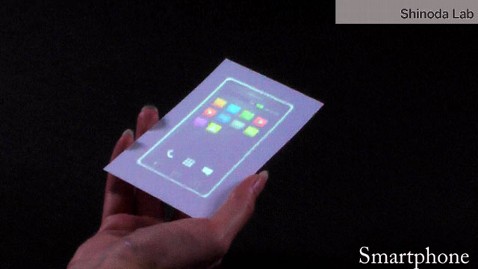Very Smart Phone Reimagines 'Talk to the Hand'

(Image Credit: IshikawaLab/YouTube)
TOKYO - It's not exactly the next big smartphone, but if you spend one too many hours searching for that misplaced iPhone, this could be even better.
Researchers at the University of Tokyo are developing a system that puts the mobile phone on the palm of your hand - literally. Using a special camera that combines high-speed vision and two rotational mirrors, Masatoshi Ishikawa and his team at the Ishikawa Oku Laboratory here say they've found a way to project a device's display screen or keyboard onto the palm, or any other surface, so that you can operate it remotely in your home or office.
Ishikawa says the system can detect the movement of a three-dimensional object every two milliseconds. Put simply, the high-speed vision allows the program to track moving objects, so users would be free to walk with the phone image in palm, without the display ever shifting.
That's not all.
The computer system developed by Ishikawa beams ultrasonic wave emitters, so the user actually feels the keyboard pressing against their skin, without anything in their hand. The sensation is the equivalent to a 3-gram or 0.1- ounce object, he says.
"You won't need a keyboard, you won't need to carry a smartphone, or a computer," Ishikawa says. "You can make a call without anything."
The concept is similar to the one featured in the movie "Total Recall" last year. In the film, Colin Farrell's character, Douglas Quaid, uses a phone embedded beneath the skin of his palm. The phone lights up, when a call comes in, allowing Quaid to answer by putting his hand to his ear.
Ishikawa says his system is far more advanced than anything featured in Hollywood, but he has yet to allow users to make actual calls from their palms. The researcher says he expects that to become reality in a year or two.
The palm phone is the latest in a string of systems Ishikawa has developed, using high-speed vision technology. Last year, he unveiled a robotic hand designed to win the game rock-paper-scissors 100 percent of the time. Processing 1,000 frames per second, the hand moved 33 times faster than humans, staying a step ahead of the opponent.
Prior to that, Ishikawa developed a mechanical finger that could dribble the ball faster than the human eye can see. Years ago, he created a batting robot capable of hitting any ball within the strike zone, every single time.
Ishikawa now hopes to perfect the projection phone, so users can dial from their palms, and view 3-D images. The phone is strictly for indoor use only, and he doesn't expect the complete system to be on the market for at least 5 to 6 years.